When you do a breeding, you never know. All the machinations and mental calisthenics don't make it successful. All the guessing, theorizing and substantiation as to why it will be a great breeding is a waste of time and effort. When it comes down to it, Mother Nature is in charge. Make your best guess, close your eyes, cross your fingers and hold your breath. Maybe you will look brilliant. Maybe you won't.
Great breedings happen in retrospect.
You think it is a safe breeding for health and three have bloated by the time they are two. Two have cancer by the time they are five. One winds up with an autoimmune disease. Two don't have clear hips. It would be far fetched to think this might happen all in one litter. The likelihood is slim. But one of these events happening is profound enough.
The worst part about breeding is dealing with the people. The best part about breeding is dealing with the people. Puppy people, especially ones who are inexperienced in the field of pure-bred dogs can be prone to see things very black and white. If it happens to their dog, it was your fault and on purpose. Some are extremely reasonable and "get" the reality of the situation. I guess it all depends on who they are in life and how they operate in the world.
Logic would support that no sane breeder WANTS a health problem to occur in one of their get. The gene pool the breeder swims in is the gene pool the breeder lives with. The breeder's own personal dogs come from the same source. The heartbreak a puppy person feels over a health problem is the heartbreak a breeder feels over a health problem in their own personal pets as well. There is no benefit for a breeder to be careless about health-it is a killer emotionally and literally-heartbreaking to one and all.
Breeding is risk taking. By its very activity the risks are present. There are unknowns, surprises good and bad. The art of breeding comes in the delicate balance struck between the knowns and unknowns. The art of breeding is the choices made in plain sight of those risks.
In my own breeding experiences I can recount ugly and unhappy stories about genetic surprises and dead ends. One story I like to retell is about two of my three foundation bitches, Tetley and Tinsel.
Both bitches came from pretty strong healthy hip backgrounds. Both had dams who were OFA Good( http://www.offa.org/) and both had sires who were OFA Good. Tetley was an OFA Good herself with one dysplastic littermate and several others who were OFA Good. Tinsel was an OFA Fair herself with two dysplastic littermates and one OFA Good littermate. Logic might tell you that Tetley would be the better hip producer than Tinsel because of the depth of her litter's hips.
Funny thing. Tetley produced multiple OFA get and multiple OFA failures in five litters. Tinsel, in three litters produced no dysplastics, six OFA Excellents (four out of one litter to Tetley's brother oddly enough) the rest OFA Goods with one Fair.
So things are not always what they appear. In subsequent generations Tinsel's hip contribution has created a foundation for a phenomenal hip record. The record of her descendents is the best the breed has ever seen. When line bred and in-bred on, it is not unusual to expect nothing less than all OFA Goods and OFA Excellents.
Mother Nature was kind in the hip department. Luck and being careful and more luck left the family of dogs I breed from very strong and dependable for clear hips. I am proud of the Deja Vu hip record. I am proud Flynn represents the Briard and the Briard Club of America as the Briard Champion for health on the OFA site. Click on Champions For Health and read Flynn's bio.
Thursday, August 20, 2009
Subscribe to:
Post Comments (Atom)

Violet at 8 months specialty weekend

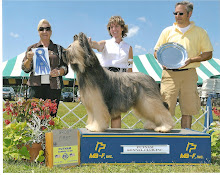





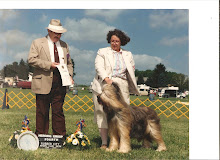

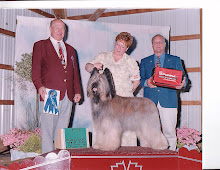
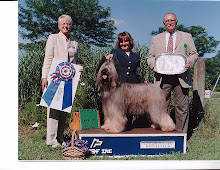


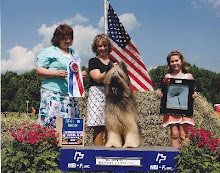






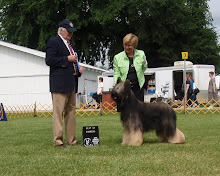
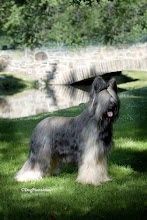




Terry,
ReplyDeleteYou are so right about it being up to Mom Nature. Now we can track (after the fact) genetic-based disease and illness with the hopes that it will help predict future potential but we're not at the predict part yet. And remember genetics isn't the 100% contribution, random mutations occur. That is part of evolution.
All we can do is our best to ensure that we are not indiscriminantly passing along genetic problems. We test, we test, we test. We can say that the dam/sire is good/excellent/clean but it is never a 100% guarentee. It just says that we've done our best to minimize the propogation of a problem.
Nice blog post. Thanks.
Rosemarie